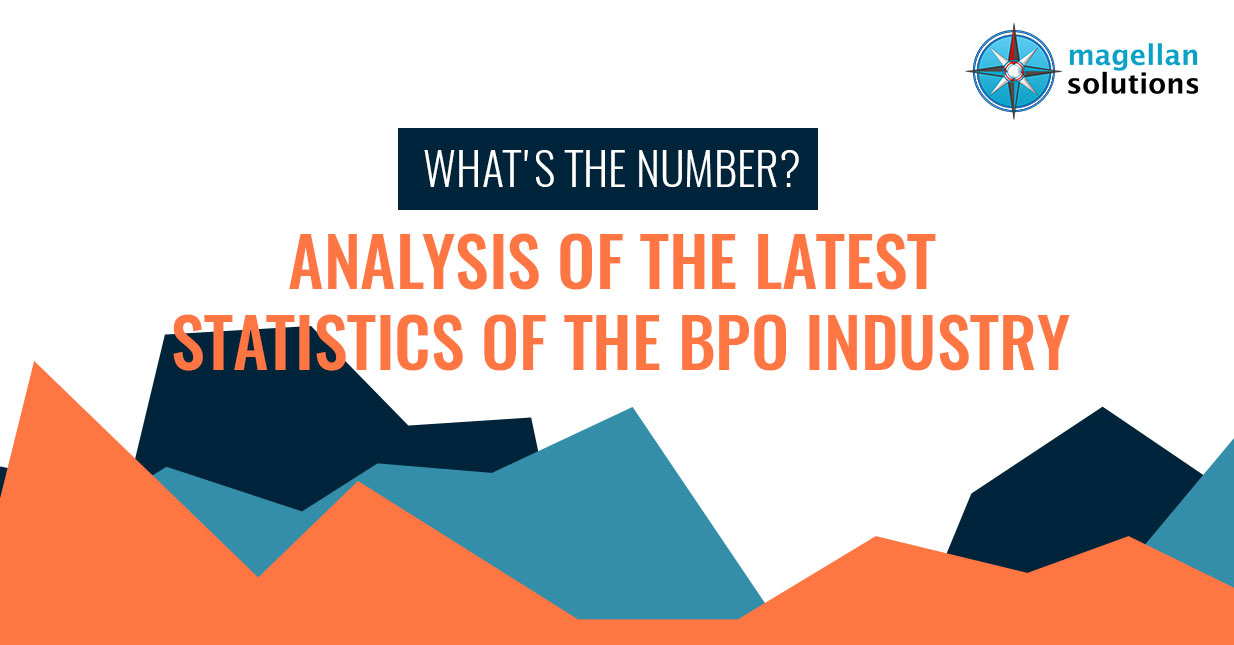Schedule a call with our outsourcing expert now and get a precise quotation that meets your requirements. Don't wait - get started today!
Update: Here’s our BPO Industry Report for 2022
2020 has been a unique and challenging year for the Philippine BPO market.
The ongoing global health crisis not only tests the resiliency of Philippine outsourcing companies but also alters the plans and projections set to strengthen the presence of the BPO industry in the country.
Despite the challenges brought by this pandemic, the business process management industry remains a pillar of the Philippine economy.
In this article, we rounded up all essential statistics and information about the Philippine BPO industry, which you can use in your outsourcing decisions.
First, let’s take a quick look at last year’s figures.
BPO Industry In The Philippines Statistics 2019
Key points:
- The IT-BPM industry contributes to the Philippines’ economy, providing thousands of jobs to Filipinos and billions to the country’s gross domestic product.
- The shift from low-level-skill tasks into mid- and high-level skills continues because of the changing demands of the global IT-BPM industry.
- Along with the projected increase in mid- and high-level skills, the healthcare sector and the animation and game development industry are expected to grow faster.
- Key industry players will continue to move to high-value complex and digital services.
- The contact center industry will still experience constant headcount and revenue growth amidst the threat of automation.
The largest employer in the Philippines
- The IT business process management (IT-BPM industry) created 71,000 new full-time jobs for Filipinos in 2019. From 1.23 million jobs, the total industry headcount grew to 1.3 million, or 5.8% higher compared to 2018.
- 29% of low-skill jobs are predicted to decline by 2022, according to the research and consulting firm Frost and Sullivan.
- Meanwhile, mid-skill jobs are projected to increase by 12%.
- High-level jobs are seen to rise by 19%.
- By 2022, 73% of the jobs in the global IT-BPM industry will require mid and high-level skilled jobs.
The IT & Business Process Association of the Philippines (IBPAP), the enabling association for the country’s IT-BPM sector, collaborates with various government and private organizations to facilitate upskilling programs to keep Filipino workers relevant and thriving in the global market.
The forecasted growth rate of PH IT-BPM services (2019-2022)
The Philippine IT-BPM industry experienced sluggish growth due to the following reasons:
- Local factors (e.g., business environment risk perception)
- Global factors (i.e., macroeconomic factors)
- Protectionist business environment (e.g., trade conflicts)
- Regulatory and geopolitical changes (e.g., GDPR, Brexit)
- The predicted increase in delivery cost due to changing regulations
- Impact of automation
Based on the Growth Forecast Executive Summary released by IBPAP, the headcount rate of the industry has the potential to grow by 4% from 2019 to 2022. The revenue growth, meanwhile, is also expected to increase by 4%.
The animation and game development subsector has the highest projected growth among the subsectors in the IT-BPM industry. It is expected to grow its revenue from 7.3% to 12.3% and its headcount by 6.8% to 11.7%.
The healthcare industry is also seen to have a faster growth rate from 2019 to 2022.
For the complete information, see the table below.
| Subsector | Headcount growth rate | Revenue growth rate |
| Contact Center and Business Processing | 2.8% – 6.7% | 3.3% – 7.4% |
| Information Technology (IT) and Software | 2.7% – 6.2% | 3.2% – 6.7% |
| Global In-House Centers (GIC) | 2.7% – 4.7% | 3.2% – 5.2% |
| Healthcare Information Management | 6.8% – 10.2% | 7.3% – 10.8% |
| Animation and Game Development | 6.8% – 11.7% | 7.3% – 12.3% |
| Overall IT-BPM | 3.0% – 7.0% | 3.5% – 7.5% |
(Source: IBPAP)
The study conducted by the Everest Group revealed that the growth of the Philippine IT-BPM sector depends on several factors and programs, such as:
- Upskilling programs for Filipino talents
- Promotion of lifelong learning
- Country branding
- Government support
- Strengthening partnerships with public and private organizations
- Focusing on the growth of SMEs and start-ups
- Mentorship from key tech experts
- Augmenting infrastructure and countryside development
According to the latest data provided by IBPAP CEO Rey Untal, the IT-BPM industry generated $26.3 billion in revenues. This is 7.1% higher than the previous year.
Meanwhile, the contact center subsector alone contributed $13 billion in revenues. It also employs the highest number of professionals in the BPO industry.
BPO Philippines Statistics 2020 and the Effects of the Pandemic on the Outsourcing Industry
The ill effects of COVID-19 have left most SMEs cash-strapped. Some struggled to survive, while others have taken the challenge to ride the tide of change from this pandemic. Larger businesses with bigger cash buffers, on the other hand, also experienced a sharp drop in revenues. This is especially true for company travel, hospitality, and tourism businesses.
The decline in demand directly affects the BPO industry in the Philippines. Some clients pulled out their accounts, leaving employees on floating status.
While these challenges delay the growth of the outsourcing market, many Philippine BPO companies still stand firm.
Check out the BPO industry in the Philippines Statistics for 2020.
Key points
- Investment pledges for January to July 2020 are 37 percent higher compared to the same period in 2019.
- IBPAP CEO Rey Untal said the pandemic will significantly affect the 2020 headcount and revenue projections. He added that it will also cause changes in the existing work and service models within the industry.
- The IT-BPM industry continued its business operations and increased its capacity amidst the community quarantines with the support of different government agencies — the Department of Trade and Industry, the Philippine Economic Zone Authority, and the Inter-Agency Task Force on Emerging Infectious Diseases.
- According to UNESCO, the Philippines has an average of 98.2 percent literacy rate — 98.2% for females and 98.1% for males.
- There are 788 BPO companies composed of large and SMEs, according to PEZA.
The economic growth of the PH IT-BPM industry
- Philippine businesses first felt the impact of the pandemic in the 2nd week of March. Even so, PEZA reported a 37-percent increase in ITBPO investment pledges from January to July. From Php8.32 billion ($172 million) in the same period in 2019, the investment pledges grew to Php11.4 billion ($235 million) this year.
- As the focus on mid- and high-value skills intensifies, 65% of BPO employees can deliver more complex and varied services for international and local clients.
- According to experts, the Philippine outsourcing services will cover 15% of the global outsourcing market by 2022. Moreover, the industry is projected to grow 9% yearly for the next five years.
Contribution to the PH Economy
- Aside from generating 1.3 million direct jobs, the industry also generated 4.08 million indirect jobs.
- It also promotes countryside development, creating 280,000 jobs in 23 provinces.
- The IT-BPM sector enables various support industries:
- Food – Php 138.1 billion ($2.7 billion)
- Banking – Php 87.3 billion ($1.8 billion)
- Real estate – Php 73.9 billion ($1.5 billion)
- Hospitality – Php 63.6 billion ($1.3 billion)
- Transportation – Php 53.8 billion ($1.1 billion)
- Other industries – Php 550.5 billion ($11.38 billion)
(Source: IBPAP Brochure)
Effects of COVID-19
- 3 out of 5 BPO employees are still employed as outsourcing companies utilize the work-from-home strategy.
- 22% of employees continue to work from the office. The government ordered BPO companies to provide on-site employees accommodation, shuttle, and meals.
- Before the lockdown, 40% of workers are already working from home.
- 18% of IBPAP member companies are looking at the option to retrench some of their employees.
- 36% of IBPAP member companies do not expect growth, while 3% to 7% still expect some change.
- Globally, the travel, hospitality, and tourism industries got the heaviest hit by the pandemic due to travel restrictions and community quarantines.
- Enforced community quarantines, which restrict people from going outside their homes, boost the growth of e-commerce-industries, financial services, and logistics.
- To adapt to the new normal, companies invest millions of dollars to facilitate the work-from-home setup.
Basic protocols implemented in BPOs
The Department of Industry (DTI), along with the Bureau of Working Conditions of the Department of Labor and Employment (BWC-DOLE), released this interim guideline on workplace prevention and control of COVID-19:
- Increasing physical and mental resilience
- Reducing the transmission of COVID-19
- Minimizing the contact rate
- Reducing the risk of infection from COVID-19
Magellan Solutions, a call center company in the Philippines, “enforces a rigorous and top-down approach in following safety protocols by all company employees starting from the top.”
According to the company’s CEO Fred Chua, “Magellan has gone several steps over to ensure safety amongst its employees by implementing UVC sanitation in all rooms, wipe downs of workstation cubicles, installation of air filtration systems, and Rapid COVID testing for returning employees and new hires. These efforts are on top of government-mandated safety measures of temperature checks, alcohol dispensers, shoe bleach pads, masks, and face shields for its employees.”
He also added that the IT team of the company implements strict security measures in deploying PCs with security software for work-from-home employees.
Magellan Solutions sets this example to prove that even a tiny BPO company can survive these challenging times. International clients who plan to outsource to the country can be confident of the services provided by Philippine BPO companies.
2020 may be a challenging year for the BPO industry. However, even a global health crisis can’t stop its growth. In the coming years, it will continue to provide jobs to millions of Filipinos and contribute billions of dollars to the country’s economy.
BPO Attrition Rate in the Philippines
Employee attrition is one of the biggest challenges in BPO companies.
The latest data revealed that the attrition rate in the IT-BPM sector is 50%. This figure is 38% higher compared to the average turnover rate of US companies at 22%.
BPO turnover and retention statistics
- 51% of agents left call centers through voluntary resignation.
- 1 in 10 agents is dismissed or retrenched by the employers.
- 1 in 10 agents did not renew the contract.
- On average, full-time employees (FTEs) who leave call centers stay with the company for 18 months, while part-time agents remain for six months.
- Team leaders stay with the company for around 1.5 years.
- Call center managers render duty for up to 4 years.
(Source: Magellan Solutions’ Call Center Benchmarking Report)
Among the reasons why BPO employees resign are the following:
- Lack of job fulfillment
- Overly strict management
- Bad work environment
- Unfair workload assignments
- Job mismatch
- Night shift work
- Lack of appreciation
- Better opportunities outside
- Physical and psychological strain
- Lack of training
To minimize the attrition rate, Philippine BPO companies put more effort into improving their culture. They also offer attractive perks and benefits such as access to the gym, free snacks, flexible working hours, and incentives for top performers.
Good things will happen amidst challenges.
Benedict Hernandez, chairman of the Contact Center Association of the Philippines (CCAP), said that the BPO roadmap to 2022 is looking bright. Local information technology-business process management (IT-BPM) is projected to have almost $40 billion in revenue after six years at the end of 2022.
Published guides for Animation and Game Development, Contact Center and BPO, IT & Software Development, and Global In-House Centers operations subsector were mentioned in the new Roadmap.
With that, BPO employees need not worry because the Philippines will not fall behind the list of countries that rule the BPO world. More and more companies will invest, meaning more jobs will be available.
Fill out the form below to create your team of BPO specialists.
TALK TO US!
Contact us today for more information.














